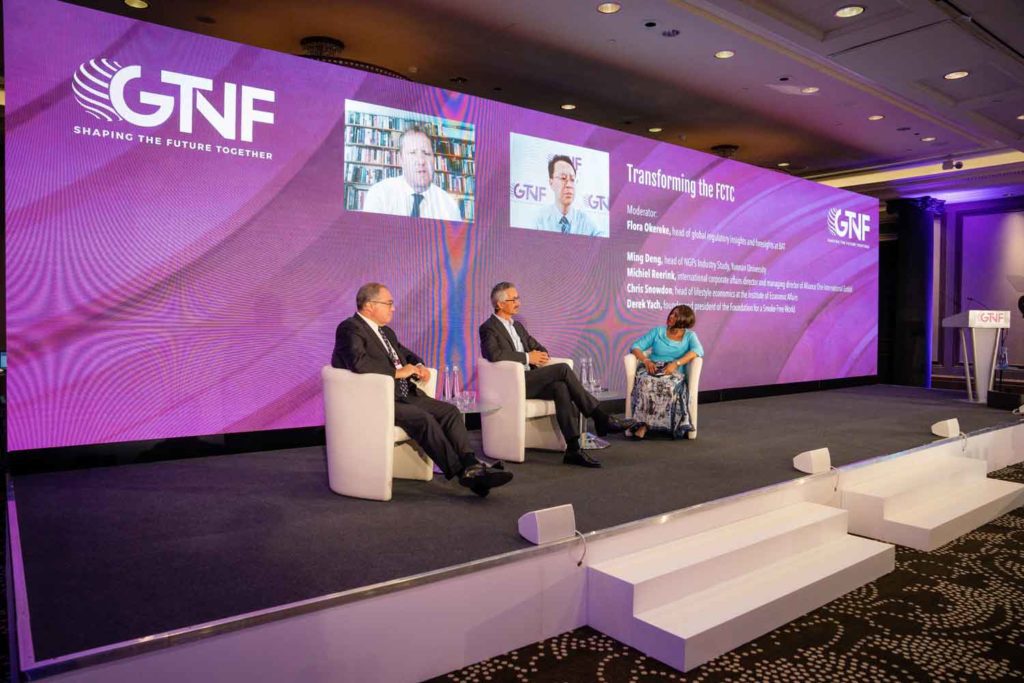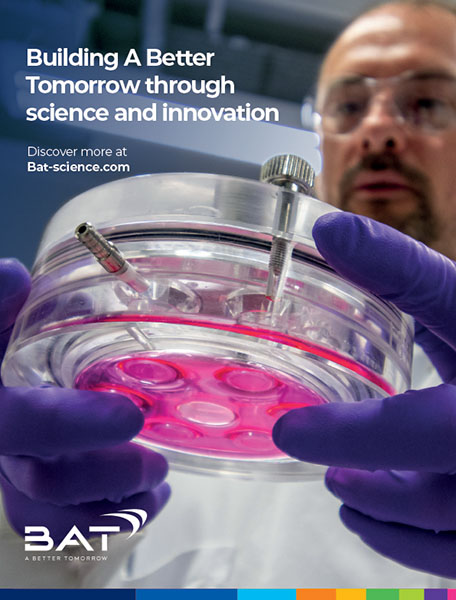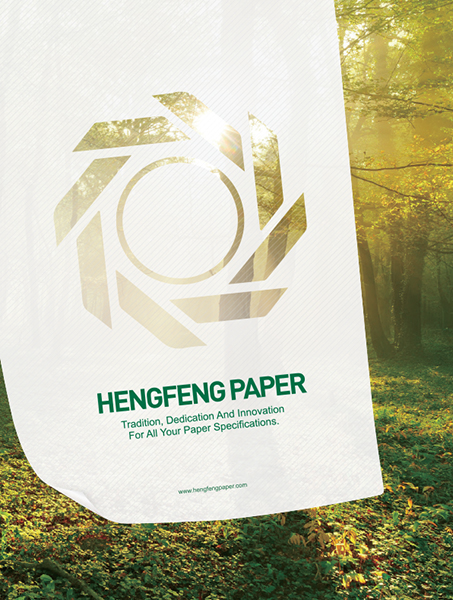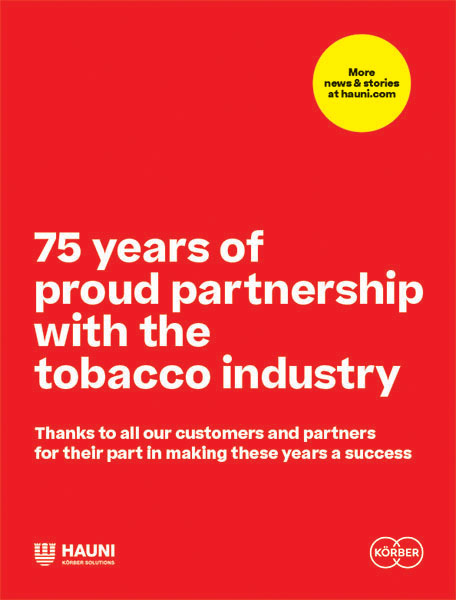A Better Treaty
- GTNF Print Edition
- October 25, 2021
- 0
- 1
- 10 minutes read


GTNF panelists offer suggestions for transforming the FCTC.
TR Staff Report
The recent Global Tobacco and Nicotine Forum (GTNF) included a well-timed panel discussion on the Ninth Conference of the Parties (COP9) to the World Health Organization’s Framework Convention on Tobacco Control (FCTC). Scheduled to take place Nov. 8–13, 2021, COP9 originally planned to convene in the Netherlands but moved online due to the persisting coronavirus pandemic.
While the delegates are unlikely to make major decisions during the virtual gathering, the shift in format could have negative implications for the nicotine business. Rather than adopting or rejecting important reports, the delegates will merely “note” them this year.
Unfortunately, experience suggests that many COP participants will treat noted reports—including those based on poor science—as adopted and start transposing their recommendations into national legislation. The result could be more counterproductive prohibitions and restrictions on potentially reduced-risk nicotine products, especially in low-income and middle-income countries (LMICs), by the time COP10 rolls around.
Moderated by Flora Okereke, BAT’s head of global regulatory insights and foresights, the GTNF discussion panel brought together top experts on the FCTC, including Derek Yach, a leading architect of the treaty and current president of the Foundation for a Smoke-Free World; Ming Deng, head of NGPs Industry Study at Yunnan University; Michiel Reerink, international corporate affairs director and managing director of Alliance One International; and Chris Snowdon, head of lifestyle economics at the Institute of Economic Affairs.

Okereke reminded her audience of how much had changed since the creation of the FCTC 20 years ago. In 2000, she recalled, there was no iPhone. The U.S. Food and Drug Administration had no authority to regulate tobacco, and the EU Tobacco Products Directive was not even on the horizon.
While the WHO claims there are 100 million fewer smokers today than there were in 2000, the FCTC and its related procedures have attracted considerable criticism from industry and tobacco harm reduction advocates, who complain about a lack of transparency and mission creep, among other shortcomings. Over the years, its detractors contend, the FCTC’s purpose of mortality reduction has evolved into a war on nicotine.
Snowdon contrasted the FCTC COP with the United Nations’ Climate Change Conference (COP26) scheduled for Oct. 31–Nov. 12 in Glasgow. The Scottish event, he predicted, will get lots of coverage. Politicians will be scrambling to get in the limelight and lining up to take credit or pass blame. Business, including fossil fuel and renewable energy companies, will be present—not only to learn what regulations governments have in store but also to show how they can be part of the solution. This, said Snowdon, is hugely different from the FCTC COP, which explicitly bans the industry it oversees from taking part in its deliberations.

While activists often justify industry exclusion by pointing to the FCTC’s infamous Article 5.3, Snowdon noted that the original objective of that section was merely to prevent the tobacco industry from interfering in health policies; it was never meant as a blanket ban on interaction. Yach recalled how the WHO in the early days of the FCTC even invited leading scientists from the tobacco industry to share their views on the direction of harm reduction. “That was the first and the last time they were ever allowed in the building,” he lamented.
The GTNF panelists also expressed concern that the FCTC has gone beyond its remit, looking to restrict not just tobacco but also products that contain no tobacco and are helping millions of people to stop smoking. As Snowdon pointed out, the treaty defines tobacco control as being “a range of supply-demand and harm reduction strategies that aim to improve the health of a population by eliminating or reducing the consumption of tobacco products and exposure to tobacco smoke.” Products such as e-cigarettes clearly do all of these things, he said—yet the WHO remains firmly opposed to such products.
Yach noted that while the FCTC text has stood the test of time relatively well, it has not properly considered innovation and intellectual property. Contrary to their counterparts in the fight against HIV/AIDS at the turn of the century, the drafters of the FCTC did not expect many technological developments to take place in their field; tobacco was generally viewed as a staid legacy sector. “How wrong we all were,” said Yach, referring to the tremendous technological advancements that have disrupted the tobacco industry in recent years.
Not all players have been equally forward thinking, however, and Yach said it was no longer appropriate to speak of “the tobacco industry.” Instead of an industry with a homogeneous view, he noted, there is now one group of players, led by publicly traded companies, making serious changes to their business, and another group, led by state monopolies, resisting change. Unfortunately, the latter group accounts for a far greater share of cigarettes sales than the first. “Many COP delegates are unaware that if you add up the sales of PMI, BAT and JTI, Imperial and Altria, they come to less than the sales of China Tobacco,” he said. However, being owned by their respective governments, the state tobacco firms are indirectly represented at COP, even as their more progressive counterparts are excluded. Deng said it was the secretariat’s job to develop a better mechanism to deal with this issue.
Yach said the industry should come together and show authorities it was willing to push the change process collectively by having a joint plan to end youth smoking, for example. Reerink reminded his audience that the industry had attempted exactly that 20 years ago, but the development got lost in other news. “I cannot blame Derek for missing it,” he said, “because it was announced on Sept. 11, 2001.” With the FCTC finances one of the few items certain to be decided at this virtual COP9, Reerink shared his insights into the budget, which he said is probably one of the treaty’s least read documents. The FCTC has a biannual budget of about $20 million. Half of that—$9 million—is reserved for “activities.” Reerink detailed how the U.K., Australia and Norway provided millions of dollars for the FCTC 2020 Project. This project, he said, is about the FCTC secretariat telling a handful of LMICs that they have to fully implement the FCTC, with bans on reduced-risk products and plain packaging. “None of these are obligations from the FCTC, but that’s the message to the LMICs,” said Reerink.

The GTNF discussion wrapped up with an audience question-and-answer session, and one delegate asked about the opportunity for the U.K., with its comparatively pragmatic approach toward new nicotine products, to influence the debate at the FCTC now that it is outside of the European Union. Yach said both the U.K. and U.S. governments have an obligation to be more vocal in the FCTC process. Even though the U.S. is not a full signatory to the FCTC, its representatives can still participate in the debate as registered observers. The U.K., he noted, is currently the world’s gold standard in reducing smoking rates. The FDA for its part, should share the scientific logic that went into its deliberations for approving marketing applications for Swedish snus and IQOS. That insight is important; due to the FDA’s unrivaled investment in regulatory science, its decisions tend to become global norms.
Asked about the path forward for reform, Yach recalled the dark days of apartheid in South Africa, when a research paper examined what would happen to the economy if the system continued on its current track versus how the economy would fare in an open democracy. That research helped galvanize the population and encouraged reforms. He encouraged the industry to present simple studies detailing how many lives could be saved if regulators integrated tobacco harm reduction, better cessation and treatment into its programs. “It’s not that difficult to give some reasonably good predictions,” he said. Such studies could be used to spur delegates into action. “You can ask them: Are you not willing to save x number of lives? What is the cost of inaction in lives lost because you are sitting around twiddling your thumbs?”

Flora Okereke, who moderated the GTNF panel on the Framework Convention on Tobacco Control, is head of global regulatory insights and foresights at BAT. In this role, she is responsible for analyzing and forecasting regulatory developments across BAT’s 180-plus global markets.
She previously held a number of senior country, regional and global roles at BAT, including legal, corporate and regulatory affairs director for West Africa; head of regulatory affairs for Africa, the Middle East and Eastern Europe; and global head of regulatory strategy and engagement.
Most recently, she served as senior director of government affairs and international policy at Reynolds American Incorporated Services, a subsidiary of RJR Tobacco based in Washington, D.C. In this role, she led engagements with U.S. government agencies, foreign embassies and global institutions on international trade, anti-illicit trade, tax and regulatory issues on behalf of Reynolds American Inc. and BAT. Prior to joining BAT, Flora was a commercial litigation solicitor in the City of London.
